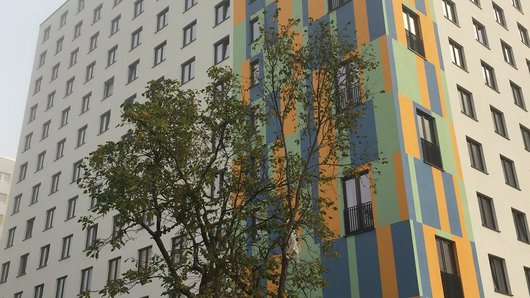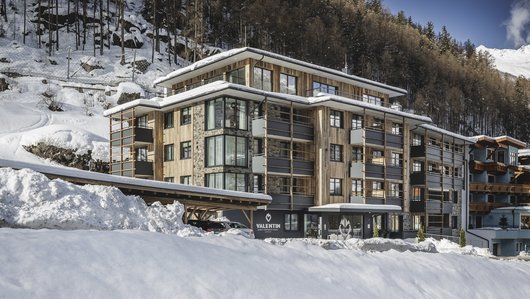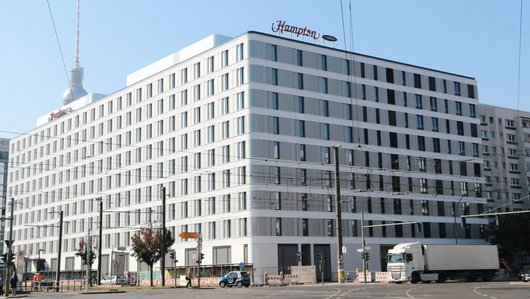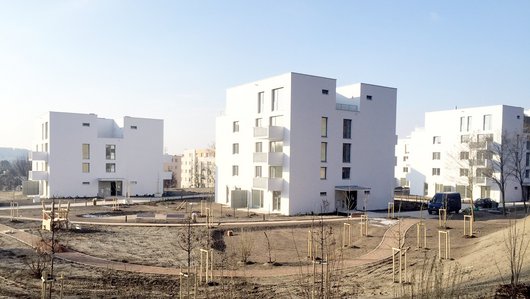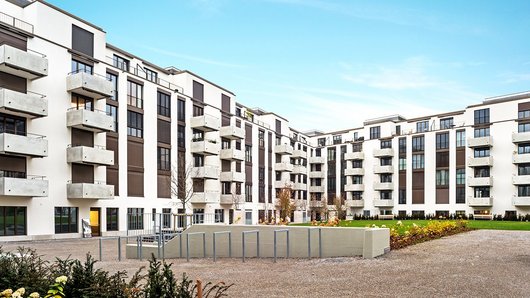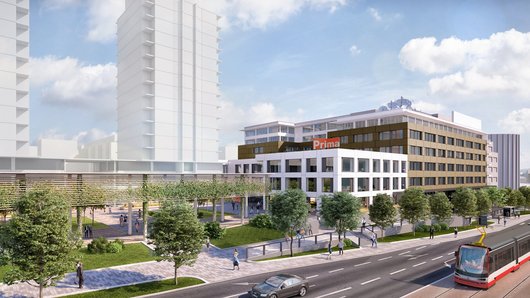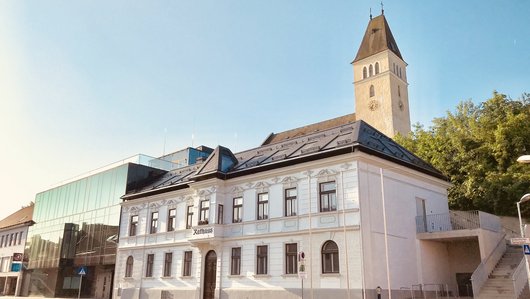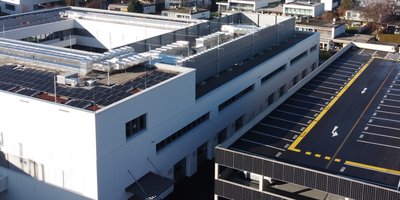
BMW Group Campus
PORR has built the BMW Group Campus, spanning over 12,000 m², in Salzburg. With BIM, LEAN Construction it was possible to deliver the project on time.
The historic administrative building was originally designed by star architect Karl Schwanzer. The extension of the Salzburg headquarters has now been combined with an impressive new building.
-
EmployerBMW Austria GmbH
-
ContractorPORR Bau GmbH
-
Architectpde Integrale Planung GmbH
-
Order typeTotalunternehmer
-
Project scopePlanung und Errichtung eines Bürokomplexes mit Trainingscenter
-
Construction startMärz 2019
-
Construction endOktober 2020
Good start
Salzburg has been an important location for the BMW Group since as far back as 1977. Now an additional EUR 28m has been invested in a 12,000 m² campus. The fact that it was completed within the planned timeframe and in line with the target costs – despite the Covid pandemic – is thanks in no small part to the consistent application of LEAN Construction and Building Information Modeling, or BIM for short. This meant that all calculations and specialist planning were presented in a digital building model right from the very start.
pde Integrale Planung was responsible for the design and planning, while the build was handled by PORR Bau GmbH. The contract was worth almost EUR 20m.
Careful planning
Before the expansion, the BMW site in Salzburg had an office building and a warehouse that were connected to each other on the lower and upper floors. The warehouse originally served as a store for spare parts, but this had long since moved out and most of the area was unused. 1,060 m² of office space was being leased nearby along with parking for around 260 cars.
BMW has forecast strong growth in this sales region. Since the additional space requirements – from the training centre to office space – could not be met in the existing building, the decision was taken to expand. The goal was to accommodate both the space being leased and any future needs on this company-owned plot. To achieve this, the plan by pde involved demolishing the warehouse and erecting a new building on top of the existing basement.
The new building provides space for a training centre with workshops and seminar rooms as well as offices and an employee restaurant. To meet the demand for parking, a multi-storey car park with three levels was built and the underground car park in the existing basement was extended.
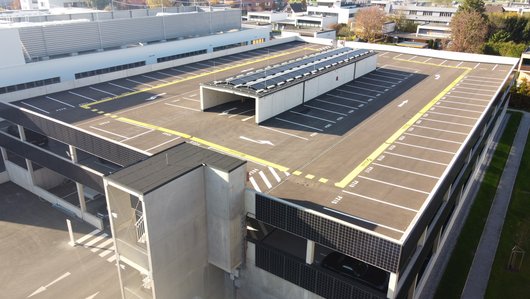

Sustainability aspects
The main goal on this project was to implement the high-quality plans within the specified timeframe. In addition, the building project was to be realised using BIM and a modular construction method with prefabricated system elements for the construction process optimised in terms of both time and costs. Furthermore, comprehensive sustainability aspects such as energy efficiency, the optimised and flexible use of space, as well as recyclability and deconstruction options were additional considerations.
The entire project was carried out with the involvement of an integral planning team from pde in order to be able to exploit any potential for optimisation in every planning phase. To implement the client’s specifications, the project planning was carried out based on LEAN design methods to facilitate the seamless introduction of the construction site team to the LEAN construction methods.
To ensure the specified costs were not exceeded, pde had already developed numerous optimisation steps during the design planning phase, which were implemented in close coordination with the client. This also meant that all trades involved in the project were required to plan in such a way that BMW’s project goals could be met within the approved budget.
In the spirit of sustainability, a large photovoltaic system was installed on the main roof of the west wing.
Clean energy
Estimates by BMW suggested that by 2028 almost 600 staff may be employed at this site, of which more than 300 workspaces would be in the new building. The desk-sharing model used by BMW promotes a flexible working environment, one that would be realised as a Flex Office as per the client’s specifications.
Mechanical ventilation is in place throughout the entire building. In order to avoid odour transmission via the ventilation system, the workshop, training centre, canteen and offices each has their own ventilation unit. Training areas, offices and the canteen are heated in winter and cooled in summer via heated and cooled ceilings. The workshops are heated by means of radiant ceiling panels.
In the spirit of sustainability, a large photovoltaic system was installed on the main roof of the west wing. The campus also offers various charging stations for electric vehicles. An access control system was installed in the office building to separate the areas. Video-over-IP cameras were installed on the facade of the office building for video surveillance.
Transparent processes
A central condition for the awarding of the contract was that the LEAN principle should not only be applied on the construction site, but right from the planning phase as well. This is why pde held weekly LEAN meetings to present the planning processes of the individual trades in a way that was transparent and easy to understand for everyone involved. To maximise the benefits and optimise the processes, the on-site subcontractors also took part.
For the planning, pde relied on the BIM software Revit by Autodesk. The resulting 3D building model included not only the architecture but the structural design as well. Due to the amount of data, a separate model was used for the building services, which was referenced in the main model to avoid any redundancies.
The plans were also created in PDF and DWG format from the Revit software in order to display the current status. Whether a task had been completed was determined exclusively using the official status sheets. The data exchange with BMW was conducted using a file server. Contractually agreed status updates, such as the plan volume of the design planning or the permit application, were additionally submitted on CD and flash drive.
Conforming to LOD 300, the level of detail of the Revit model corresponded to that of a model for permit application purposes. BMW did not require the model to be used for facility management after the handover of the building.
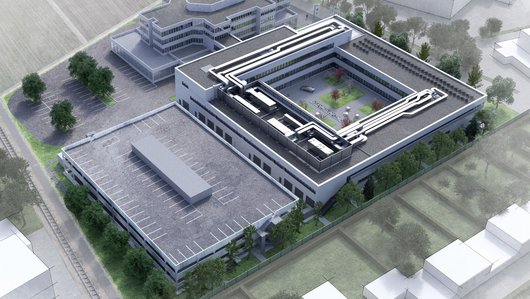

Successful conclusion
Almost one-and-a-half years after construction began, PORR was able to hand over the campus to the BMW Group in October 2020 – on time and on budget. The extension has space for an ample training centre, employee restaurant, 470 parking spaces, and office space for 450 employees from 16 nations.
Technical data
-
Bruttogeschossflächeapprox. 15,565m²
-
Grundstücksfläche17,216m²
-
Baugrubentiefe5m
-
PKW-Stellplätze470
-
Length of connecting bridge20m
-
Aushub15,000m³
-
Asphaltapprox. 5,000m²
-
Jet-grouted columns100
-
Verbauter Stahl40t
-
Verbauter Betonapprox. 4,100m³
-
Verbauter Betonstahlapprox. 390t

